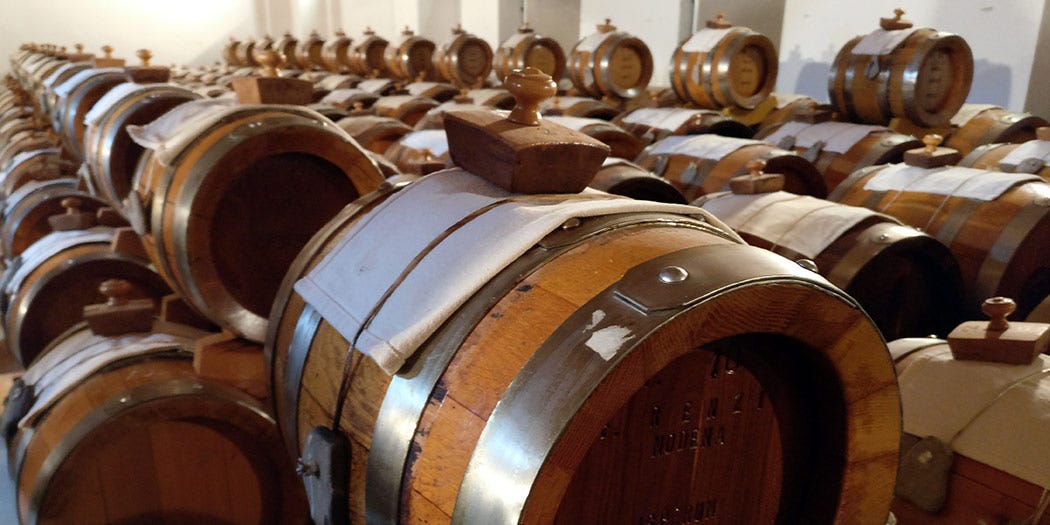The “balsamics”
Do tell, is that a jaunty touch of Modena in my Merlot?
This article is also available on Hudin.com.
So many tasting notes that accompany wines (especially on the back labels) are simply laughable.
Somehow it’s believed that, “Fresh, but strong”, “Forward and yet reserved”, or “Very much beef, but not quite cow” actually mean something. Thankfully I’ve never actually seen that last one in the wild, only the concept of it.
This laughable state is to a large degree unfortunate, as tasting notes, when done correctly, are actually a fine system to understand a wine without having tasted it. A great example of this is with deductive blind tasting practice in pairs, where one person will smell and taste a wine, describing it for another person who then has to identify it based upon the aspects that were listed. When both people are well-trained in the system, it’s quite reasonable to achieve reliable results.
Any normal person would find this to be insanity as thankfully for everyone else who just wants to enjoy the liquid, points became a popular system. It’s much easier to understand that a wine which costs 10€ and has 93 points is a solid value and gives a lot more satisfaction than trying to understand if it’s the wine with dry strawberries or fresh wild strawberries that’s the better option. That said, you still need all the lunatics doing blind tasting practice to be able to reliably understand wines to dole out the points.
As an outsider who arrived to Catalunya already trained in wine, I discovered that some things were a touch, well, “different”. Indeed fruits and herbs come into play, but so do a lot of words that really have no business being there. A phrase such as “un fons làctic” (a lactic bottom/background?) tells you exceptionally little about that wine if you’re trying to understand the wine beyond simply being a number.
This “different” approach to tasting notes then trickles into any kind of deductive blind tasting system as I see that those who win contests here as simply people who have tried the wines before and seem to remember them. There’s no logical conclusion and it’s less blind tasting and much more, blind guessing.
All that said, I could probably leave much of this without comment as it’s simply a different “way” to go about things but there’s the issue that we live in international times and wines travel far from their points of origin. This is an issue as the tasting notes travel as well and there is one single descriptor in Catalan (as well as in Spanish and French) that rubs me very much the wrong way and that word is, “balsamic”.
Simply put, this is not an aroma in any wine for drinking. In fact, if a wine has an actual note of “balsamic” that means it’s very flawed given that acetic bacteria has been allowed to flourish, producing volatile acidity, making the wine go “sour” or turn into vinegar–a fine product on its own, but definitely not wine.
When I’ve attended wine tastings in the past and watched a person leading one declare a wine to have “bons balsàmics”, I was always trying to figure out what on earth they were getting at. I was double-baffled when I witnessed a white wine described as having “balsamics” at this recent Vins de Finca presentation.
The only two references I’ve been able to track down (originally in Spanish) have said that balsamics are:
“This aromatic sensation usually occurs in some aging wines aged in the sun. Balsamic aromas are, for example: pine, resin, juniper, and eucalyptus.”
Or then:
“…a penetrating aroma that the wines give off when they pass through a wooden barrel. It is a smell that is reminiscent of resin and offers a very pleasant sensation of freshness.”
It’s clear to see that aging plays a part in it and some of the notes seem to be misplaced barrel aging descriptors. It took me some time, but I finally realized that this is actually sloppy shorthand for stating “tertiary notes” without having to break them, nor the aspects of aging into individual aspects.
My reasoning for this is that I never hear any description of the aromas which develop as a wine ages. Words such as: tobacco, earth, mushroom, almond, hazelnut, leather, cocoa, coffee, and a number of others were more often absent than present and if absent, “balsamic” would take their place.
This is much like how “footing” became used to say “running” or even better how “showcooking” (which obviously doesn’t exist in English) came to be used to say, “cooking demonstration”. It would seem that “balsamics” has become an accepted word despite its exceptionally confusing quality that more importantly shows a massive lack of tasting ability of those who use it. Don’t believe me? Try to write it as an aromatic descriptor on a WSET, Court of Master Sommeliers, or Masters of Wine exam and see what happens.
So, if you find yourself using this to describe a wine, first, never use it with an English speaker and in general, stop immediately and go back to review the aromas of aged wines. If in doubt of what to taste, Rioja Gran Reserva wines are legends in the aged red wine department as well as Sherry for white wines.
While at it, maybe review oak aging aroma notes too which can lead into the tertiary notes.
If there’s anyone who questions what I’m getting at here, then I recommend doing the paired blind tasting exercise I mentioned above and tell you partner that you detect, “balsamics” and see if they respond, “Ah, of course, it’s a Modena!”




Good luck with this venture,Miquel. Probably not for me though.
Essentially "balsamics" is herbal or is it a catchall for WSET tertiary aromas you listed? So interesting that it indicates the *act* of aging (turning to balsamic) rather than the *flavor* of aging (Modena). Language!!